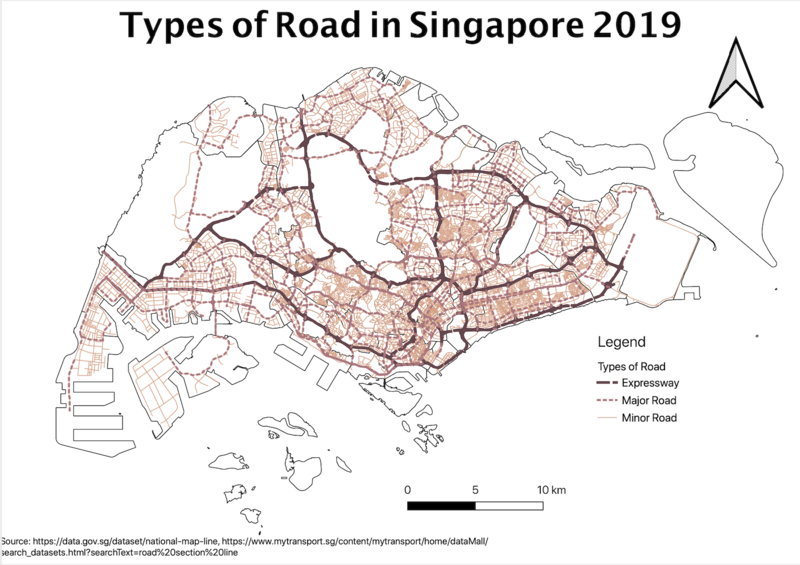Difference between revisions of "SMT201 AY2019-20T1 EX1 Riana"
Riana.2016 (talk | contribs) |
Riana.2016 (talk | contribs) |
||
| Line 14: | Line 14: | ||
=== Aged population (+65) in 2010 === | === Aged population (+65) in 2010 === | ||
| + | <br>[[File:Aged Population ( 65) in 2010.png|800px|frameless|center]]<br> | ||
| + | Firstly, in order to join to the subzone planning area data, I changed the subzone in the population data to uppercase using excel before importing to QGIS. Then, in order to cut down the processing time, I filtered the data by year 2010 and age group of 65 and above. Afterwards, I use GroupStats plugin to get the sum the aged population by the subzone and join the data with the subzone planning area data. I have used equal interval classification to classify the number of population in each subzone. I chose equal interval as it gives me a better insight of the area that are more aged population. I did not deal with any missing value in this map as I have use another subzone planning area map as a base map. | ||
| + | From this map, we can infer that there are more aged population in the east side of Singapore in the year 2010. | ||
=== Aged population (+65) in 2018 === | === Aged population (+65) in 2018 === | ||
| + | <br>[[File:Aged Population ( 65) 2018.png|800px|frameless|center]]<br> | ||
| + | The steps to derive this map is exactly the same with the Aged Population in Singapore 2010 map. In this map, I found that there are no missing value, therefore, I can dispose the use of a base map. From the classification, we can see that the number of aged population has increase 1.5 times compared to 2010. However, the distribution of the area with high number of aged population is still remained the same as 2010, which is on the east side of Singapore. | ||
=== Proportional of aged population in 2010 === | === Proportional of aged population in 2010 === | ||
| + | |||
=== Proportional of aged population in 2018 === | === Proportional of aged population in 2018 === | ||
=== Percentage change of aged population between 2010 and 2018 === | === Percentage change of aged population between 2010 and 2018 === | ||
Revision as of 01:50, 15 September 2019
Part 1: Thematic Mapping
Distribution of public education institution by school types
Due to the nature of the data, I chosen a different shape and colors to represent the type of school. A different color is used on top of the different shapes as the different types of school are cluster together. Therefore, variety of colors are used for better visualization. Besides the school type, I chosen a different color to represent the different region of Singapore to categorize the region of the school in one glance. Furthermore, a different color scheme is used to distinguish the region and school type.
Road network system of Singapore
For this map, I use the different types and thickness of the lines and different colors to represent different types of road. Since expressway is the most important road, I use a thicker line to represent it, then follow by major road and minor road. In order to distinguish the line more, I used the different types of line to represent each of the road. Classification of expressway and major road is retrieved from the data.gov.sg while the minor road is retrieved from LTA DataMall.
2014 Master Plan Landuse
For this map, I have used a different colors and pattern to represent the different landuse purpose. Since there are a lot of categories from the data, I combined some of the categories such as Residential and Business. Besides colors, I used patterns to further distinguish the landuse. Furthermore, I have chosen colors that are the closest to the categories, e.g. red for restricted area and blue for waterbody.
Part 2: Choropleth Mapping
Aged population (+65) in 2010
Firstly, in order to join to the subzone planning area data, I changed the subzone in the population data to uppercase using excel before importing to QGIS. Then, in order to cut down the processing time, I filtered the data by year 2010 and age group of 65 and above. Afterwards, I use GroupStats plugin to get the sum the aged population by the subzone and join the data with the subzone planning area data. I have used equal interval classification to classify the number of population in each subzone. I chose equal interval as it gives me a better insight of the area that are more aged population. I did not deal with any missing value in this map as I have use another subzone planning area map as a base map. From this map, we can infer that there are more aged population in the east side of Singapore in the year 2010.
Aged population (+65) in 2018
The steps to derive this map is exactly the same with the Aged Population in Singapore 2010 map. In this map, I found that there are no missing value, therefore, I can dispose the use of a base map. From the classification, we can see that the number of aged population has increase 1.5 times compared to 2010. However, the distribution of the area with high number of aged population is still remained the same as 2010, which is on the east side of Singapore.




